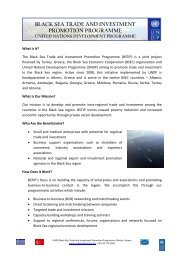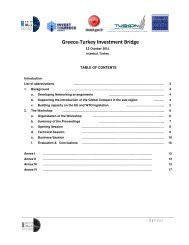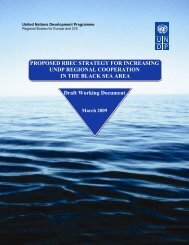Tradeflow Study - UNDP Black Sea Trade and Investment Promotion ...
Tradeflow Study - UNDP Black Sea Trade and Investment Promotion ...
Tradeflow Study - UNDP Black Sea Trade and Investment Promotion ...
You also want an ePaper? Increase the reach of your titles
YUMPU automatically turns print PDFs into web optimized ePapers that Google loves.
.<br />
II.1.3 Intra-industry trade between BSEC Member States<br />
Although trade flows are determined by differences in comparative advantages, a wide range<br />
of other factors also influence the success or failure of efforts to promote industrialization <strong>and</strong><br />
growth. In the context of globalisation of supply chain management <strong>and</strong> assembly operations,<br />
there is a growing level of intra-industry trade (IIT), which plays an important positive role in<br />
the success of economic growth. Theory suggests that intra-industry exchange produces<br />
extra gains from international trade over <strong>and</strong> above those associated with comparative<br />
advantage because it allows a country to take advantage of larger markets through<br />
specialisation.<br />
The IIT index ranges between zero <strong>and</strong> one (or 0 percent <strong>and</strong> 100 percent), with larger values<br />
indicating a greater level of trade between firms in the same industry. Higher IIT ratios<br />
suggest that net gains from specialization in different products are being exploited <strong>and</strong> that<br />
the participating country is increasing its integration into the world economy. In the context of<br />
this study, this suggests that both intra-industry trade opportunities are high <strong>and</strong> that the<br />
export sector has become relatively sophisticated. The IIT index within the BSEC region is<br />
calculated as<br />
IIT 1 <br />
jk<br />
xijk<br />
mijk<br />
i<br />
xijk<br />
mijk<br />
<br />
i<br />
Where i, j <strong>and</strong> k indicate industry, home country <strong>and</strong> partner country, respectively. X ijk <strong>and</strong><br />
M ijk represent exports <strong>and</strong> imports of industry i in country j to country k, respectively. Figure 3<br />
displays the overall IIT index for each country with regards to the BSEC <strong>and</strong> the total trade<br />
within the region for each country. One can note that the highest levels of IIT are recorded for<br />
Romania <strong>and</strong> Bulgaria while the lowest levels relate to Albania, Armenia, Azerbaijan, Serbia<br />
<strong>and</strong> Montenegro, <strong>and</strong> Ukraine.<br />
Based on the results, it seems that Romania <strong>and</strong> Bulgaria have the highest integration in<br />
supply chains, <strong>and</strong> Greece, Russia <strong>and</strong> Turkey also displaying relatively high levels of intraindustry<br />
trade. It should be noted that the IIT can also be influenced by other factors such as<br />
the aggregation of statistics with the result that often distinct production processes are<br />
classified under the same chapter heading. For the purposes of this study, the two digit level<br />
was used. The detailed results of the IIT are given in Annex 1 in Table A6.<br />
26/135






